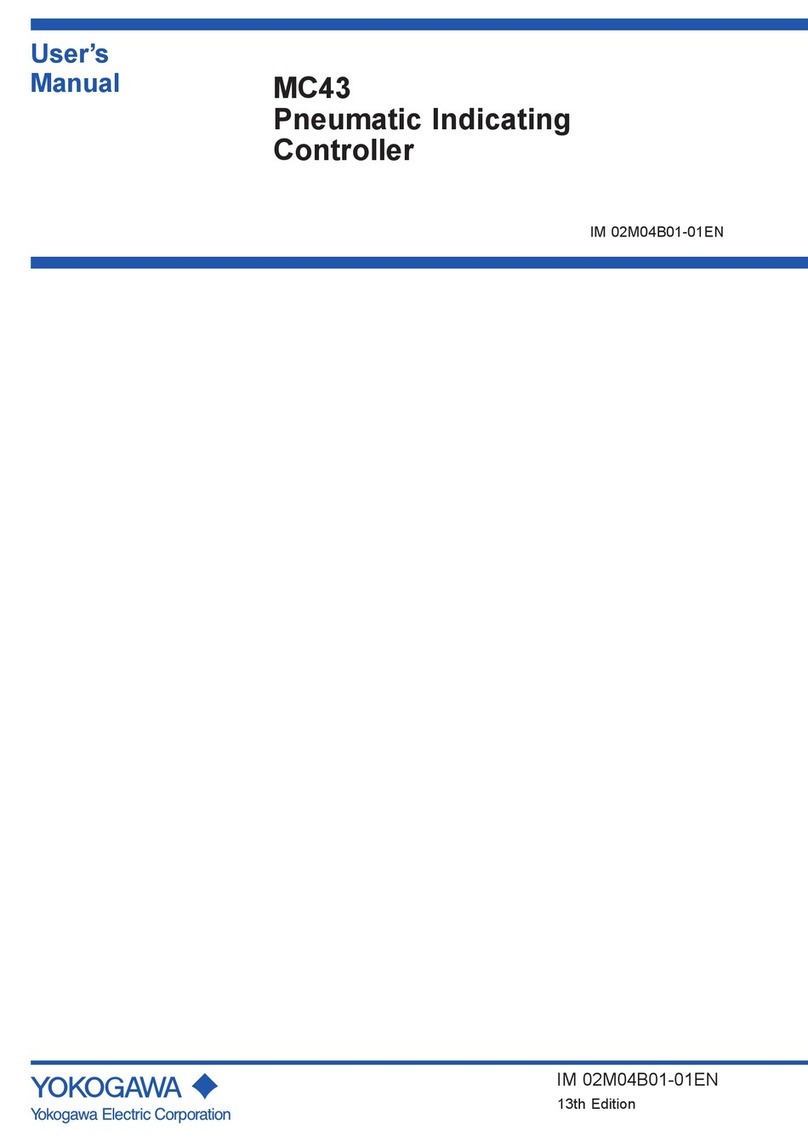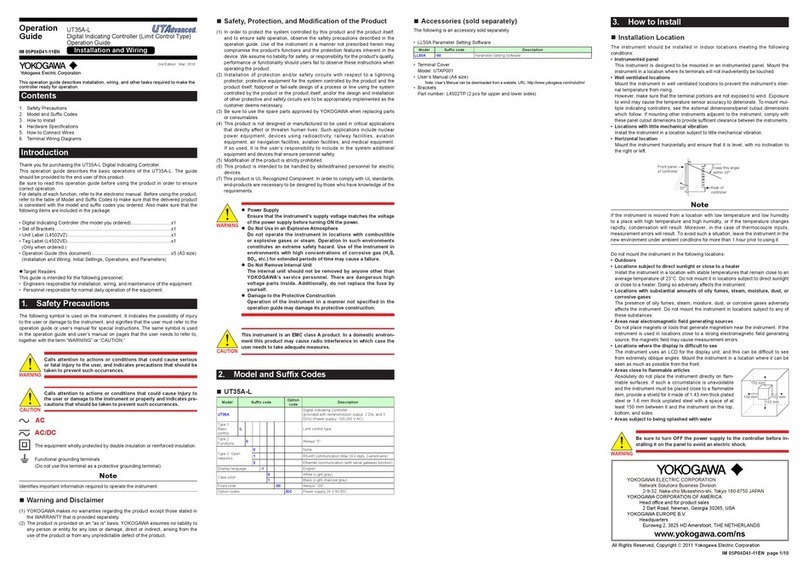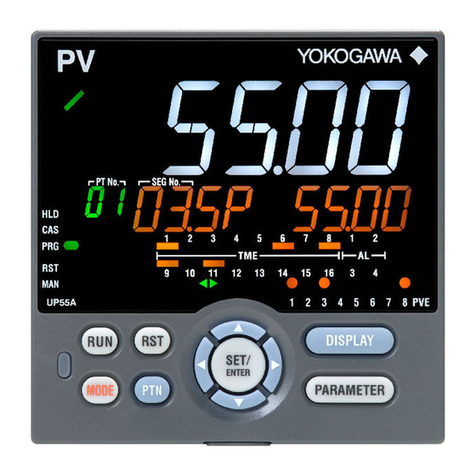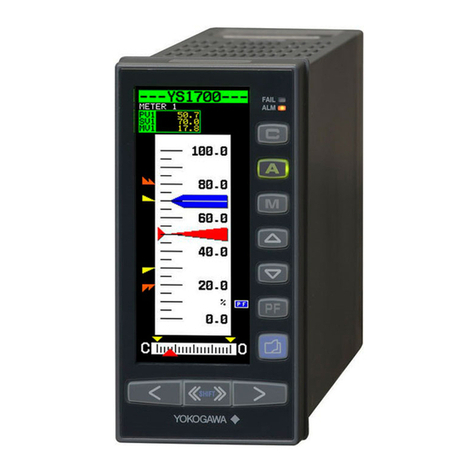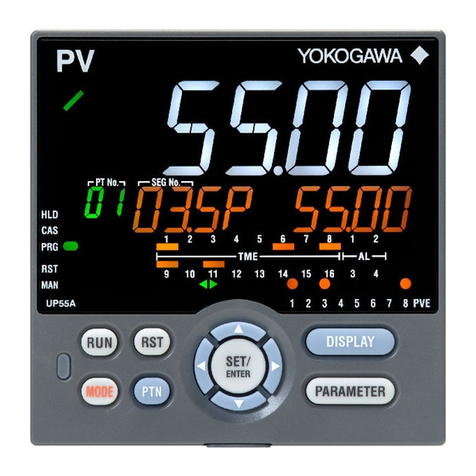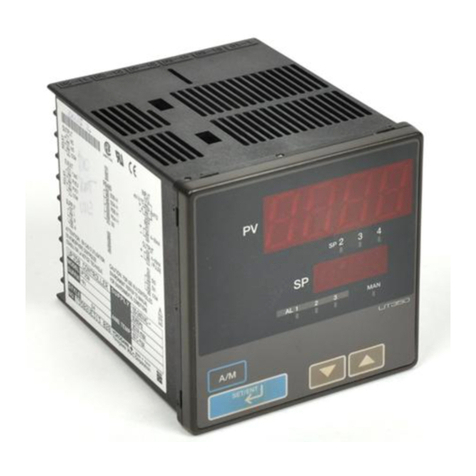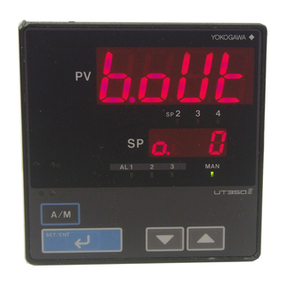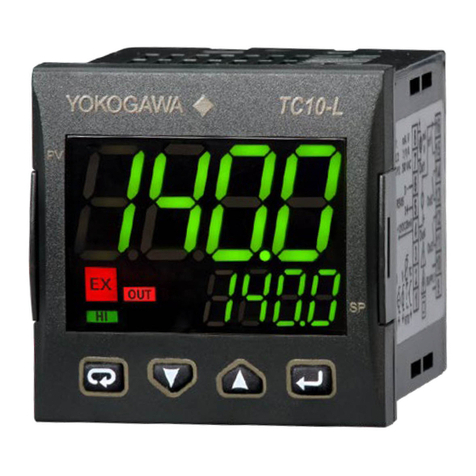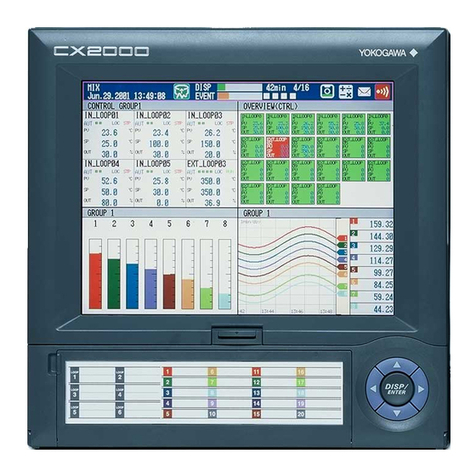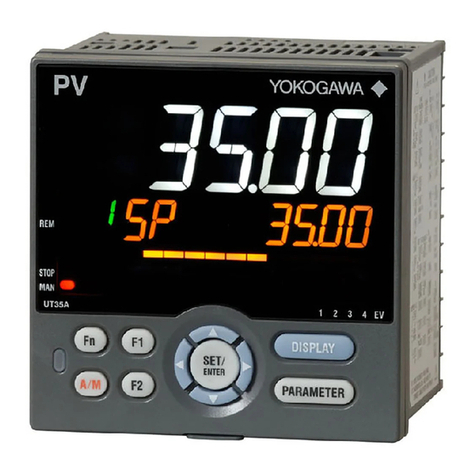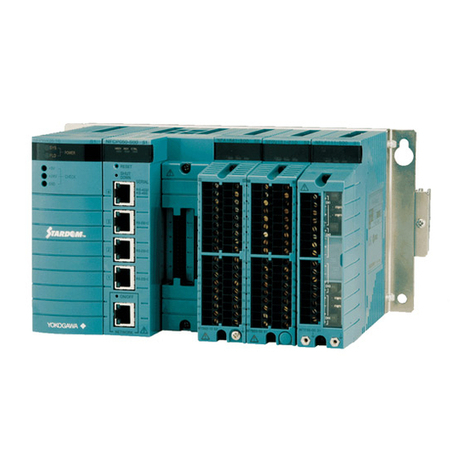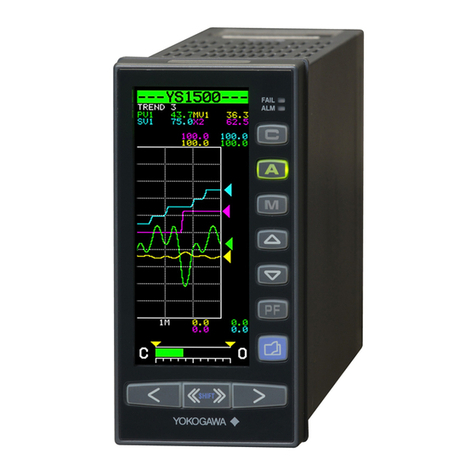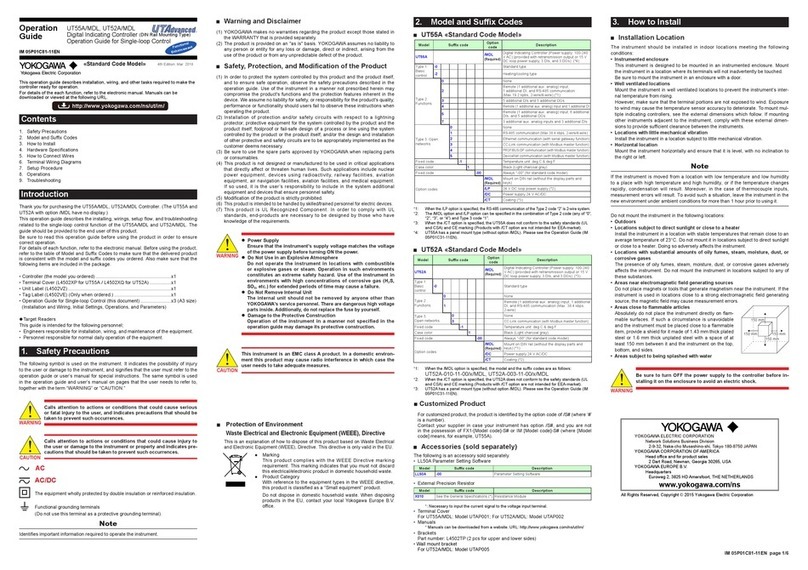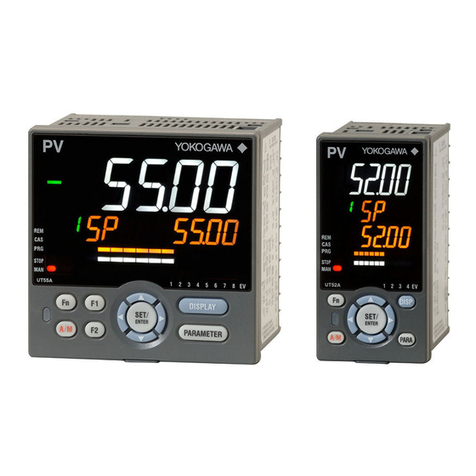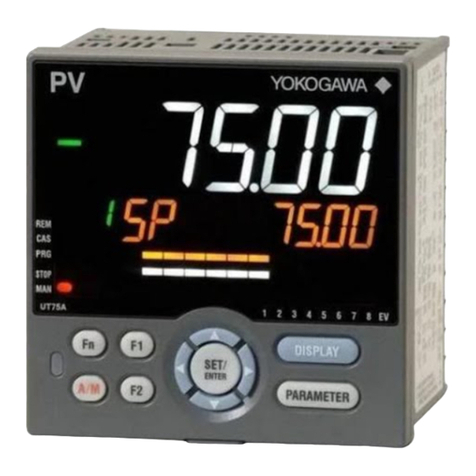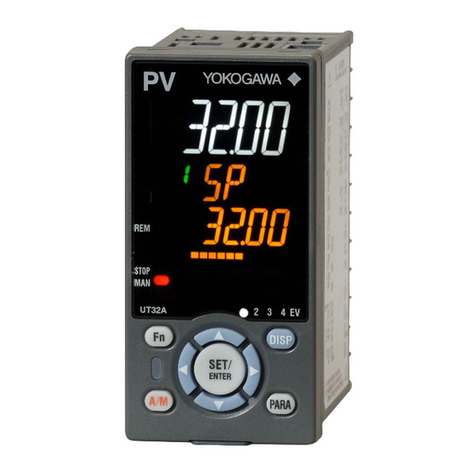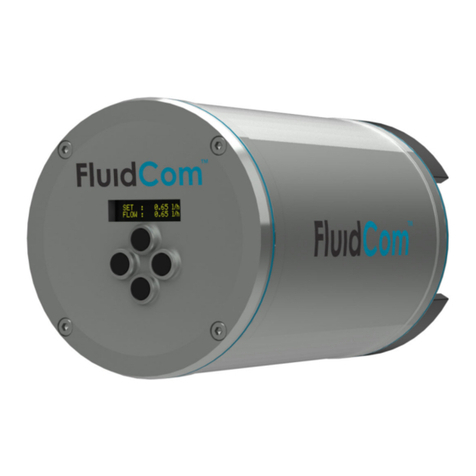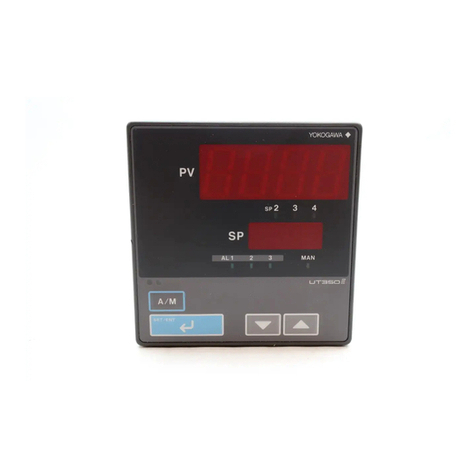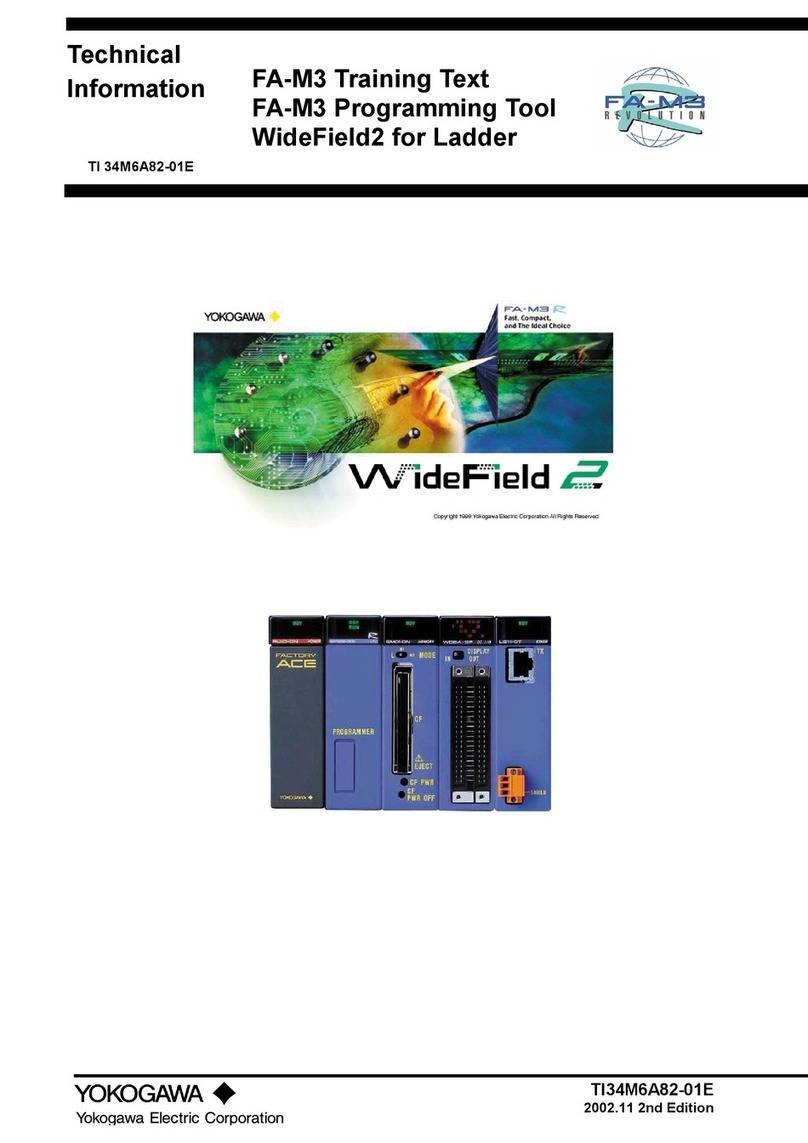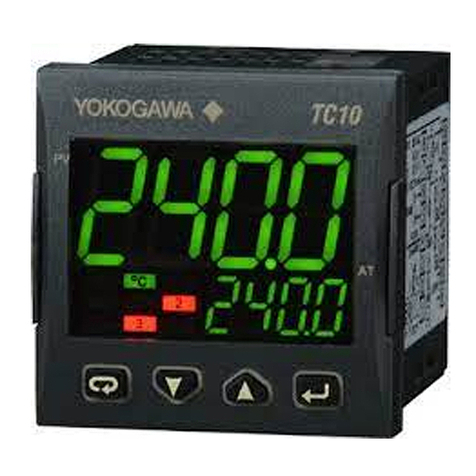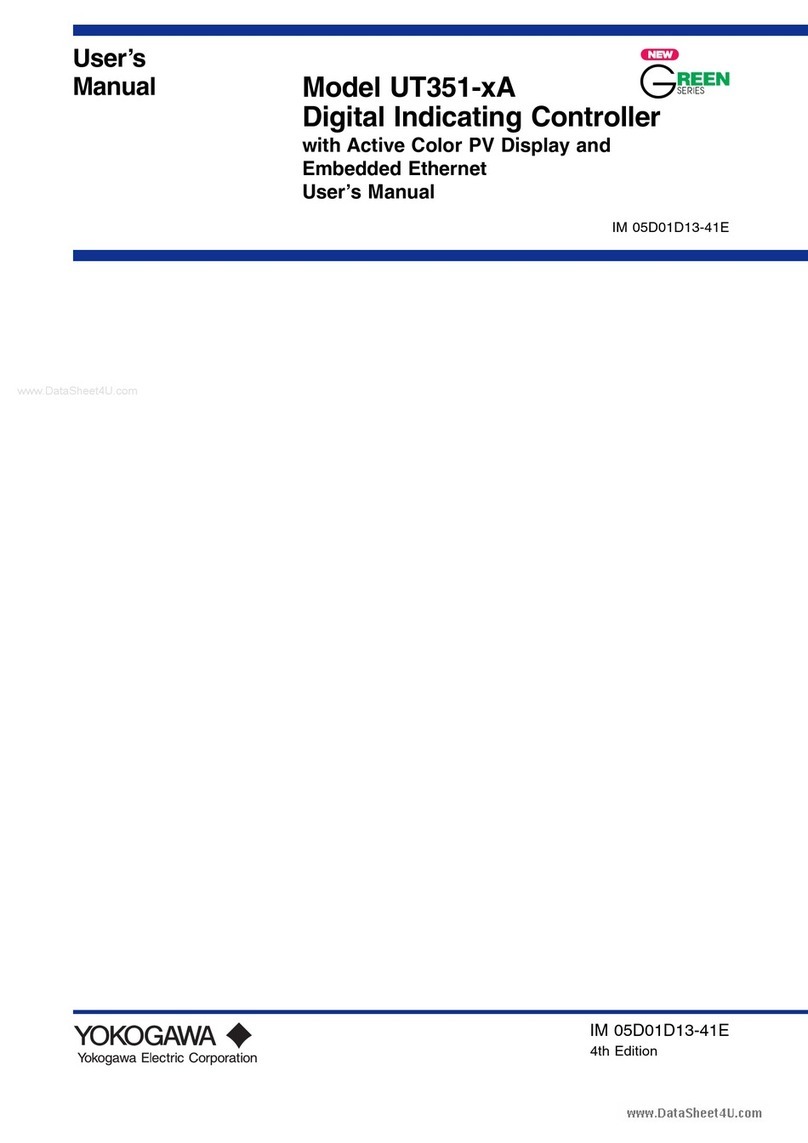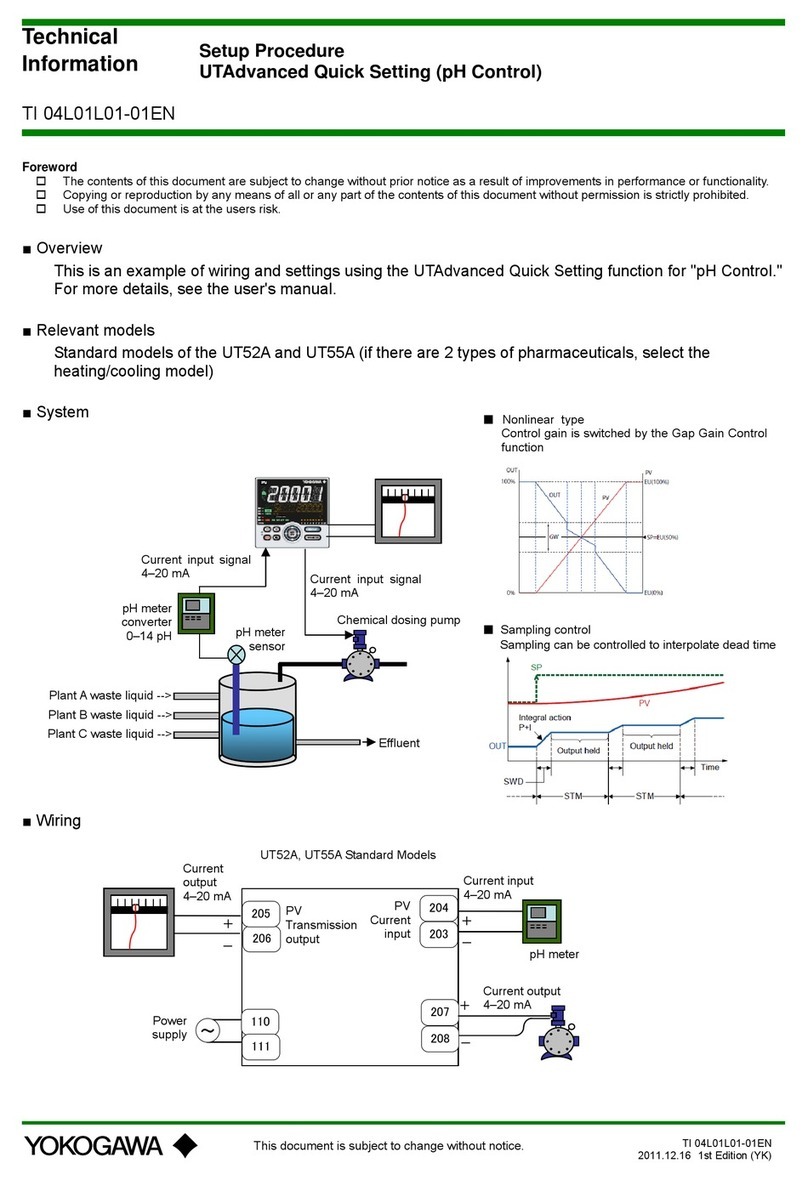
Arrangement of the Terminal Blocks
VIDEOOUT(VGA)
LN
Analog Input Terminal Block
(Terminal number: 001 to 036)
Measurment Input Terminal Block
(Terminal number: 101 to 136)
Measurment Input Terminal Block
(Terminal number: 201 to 236)
Control Output Treminal Block
(Terminal number: 301 to 336)
Control Output Treminal Block
(Terminal number: 401 to 436)
Control Output Treminal Block
(Terminal number: 501 to 536)
)
Option Terminal Block
(Terminal number: 601 to 636)
1
2
0
0 6
5
6
4
3
to
Terminal block number
Chracters indicating the type
of input/output signal
Te r minal number
005
A
+
One screw terminal is shown in the figure below. The upper and lower symbols
represent a unique terminal number and the terminal type, respectively.
No screw terminal is attached.
C: Common
NO: Normally Opened
NC: Normally Closed
mA: Current output
PULSE: Voltage pulse output
Input Assignments of the Analog Control Input
Terminal Block (Terminal Block: 0)
6 loops
LOOP1
PV(RSP)
LOOP2
PV(RSP)
LOOP3
PV(RSP)
LOOP4
PV(RSP)
LOOP5
PV
LOOP6
PV
PV(RSP)PVPV(RSP)PV PVPV
PV1PV2PV1PV2PV1PV2PV1PV2 PV
PV
028
029
030
b
A
+
B
−
031
032
033
b
A
+
B
−
025
026
027
b
A
+
B
−
022
023
024
b
A
+
B
−
019
020
021
b
A
+
B
−
016
017
018
b
A
+
B
−
013
014
015
b
A
+
B
−
010
011
012
b
A
+
B
−
007
008
009
b
A
+
B
−
004
005
006
b
A
+
B
−
During single loop control
During cascade control
During loop control with
PV switching
[Control mode setting]
4 loops
LOOP1
PV(RSP)
LOOP2
PV(RSP)
LOOP3
PV(RSP)
LOOP4
PV(RSP)
PV(RSP)PVPV(RSP)PV
PV1(RSP) PV2PV1PV2PV1PV2(RSP)PV1
PV2
028
029
030
b
A
+
B
−
031
032
033
b
A
+
B
−
025
026
027
b
A
+
B
−
022
023
024
b
A
+
B
−
019
020
021
b
A
+
B
−
016
017
018
b
A
+
B
−
013
014
015
b
A
+
B
−
010
011
012
b
A
+
B
−
007
008
009
b
A
+
B
−
004
005
006
b
A
+
B
−
During single loop control
During cascade control
During loop control with
PV switching
[Control mode setting]
2 loops
LOOP1
PV(RSP)
LOOP2
PV(RSP)
PV(RSP)PV
PV1PV2(RSP)PV1PV2
During single loop control
During cascade control
During loop control with
PV switching
[Control mode setting]
016
017
018
b
A
+
B
−
013
014
015
b
A
+
B
−
010
011
012
b
A
+
B
−
007
008
009
b
A
+
B
−
004
005
006
b
A
+
B
−
Terminal Assignments of the Control Output
Terminal Block (Terminal Blocks: 3, 4, and 5)
Loop 1 and 2 (Terminal block: 3)
Contact
input
Transistor
output
Control current/
voltage pulse output
relay contact
output
LOOP1LOOP21
Control relay
contact output
LOOP1LOOP2 2
525
526
527
528
529
530
522
523
519
520
516
517
518
513
514
515
510
511
512
507
508
509
504
505
506
4
5
6
3
4
C
5
6
C
mA
PULSE
C
mA
PULSE
C
NO
C
NO
C
NO
NC
C
NO
NC
C
1
2
3
501
502
503
Loop 3 and 4 (Terminal block: 4)
Contact
input
Transistor
output
Control current/
voltage pulse output
relay contact
output
LOOP3LOOP41
Control relay
contact output
LOOP3LOOP4 2
525
526
527
528
529
530
522
523
519
520
516
517
518
513
514
515
510
511
512
507
508
509
504
505
506
4
5
6
3
4
C
5
6
C
mA
PULSE
C
mA
PULSE
C
NO
C
NO
C
NO
NC
C
NO
NC
C
1
2
3
501
502
503
Loop 5 and 6 (Terminal block: 5)
Contact
input
Transistor
output
Control current/
voltage pulse output
relay contact
output
LOOP5LOOP61
Control relay
contact output
LOOP5LOOP6 2
525
526
527
528
529
530
522
523
519
520
516
517
518
513
514
515
510
511
512
507
508
509
504
505
506
4
5
6
3
4
C
5
6
C
mA
PULSE
C
mA
PULSE
C
NO
C
NO
C
NO
NC
C
NO
NC
C
1
2
3
501
502
503
Terminal Assignments of the Measurement Input
Terminal Block (Terminal Blocks: 1 and 2)
Channel 1 to 10 (Terminal block: 1)
Channel number
1245679
10 38
128
129
130
b
A
+
B
−
131
132
133
b
A
+
B
−
125
126
127
b
A
+
B
−
122
123
124
b
A
+
B
−
119
120
121
b
A
+
B
−
116
117
118
b
A
+
B
−
113
114
115
b
A
+
B
−
110
111
112
b
A
+
B
−
107
108
109
b
A
+
B
−
104
105
106
b
A
+
B
−
Channel 11 to 20 (Terminal block: 2)
Channel number
1112141516171920 1318
228
229
230
b
A
+
B
−
231
232
233
b
A
+
B
−
225
226
227
b
A
+
B
−
222
223
224
b
A
+
B
−
219
220
221
b
A
+
B
−
216
217
218
b
A
+
B
−
213
214
215
b
A
+
B
−
210
211
212
b
A
+
B
−
207
208
209
b
A
+
B
−
204
205
206
b
A
+
B
−
Terminal Assignments of the Option Terminal
Block (Terminal Block: 6)
/CTS1
Contact input
Transistor output
625
626
627
628
629
630
622
623
619
620
613
614
615
610
611
612
607
608
609
604
605
606
4
5
6
7
8
9
10
11
12
C
C
C
1
2
2
4
5
6
C
7
8
C
628
629
630
9
10
C
628
629
630
11
12
C
1
2
3
601
602
603
/A6
Alarm output
625
626
627
628
629
630
619
620
610
611
612
NC
C
NO
NC
C
NC
C
NO 621
NO
NC
C
NO
616
617
618
NC
C
NO
06 05 04 03 02 01
634
635
636
NC
C
NO
/A6R
Measurement remote input
Alarm output
625
626
627
628
629
630
619
620
610
611
612
607
608
609
604
605
606
3
4
5
6
7
8
NC
C
NO
NC
C
NC
C
NO 621
NO
NC
C
NO
616
617
618
NC
C
NO
06 05 04 03 02 01
634
635
636
NC
C
NO
C
1
2
601
602
603
/A4F
FAIL
output
Memory end
output Alarm output
625
626
627
628
629
630
619
620
610
611
612
NC
C
NO
NC
C
NC
C
NO 621
NO
NC
C
NO
616
617
618
NC
C
NO
04 03 02 01
634
635
636
NC
C
NO
/A4RF
Measurement remote input
FAIL
output
Memory end
output Alarm output
625
626
627
628
629
630
619
620
610
611
612
607
608
609
604
605
606
3
4
5
6
7
8
NC
C
NO
NC
C
NC
C
NO 621
NO
NC
C
NO
616
617
618
NC
C
NO
04 03 02 01
634
635
636
NC
C
NO
C
1
2
601
602
603
/TPS4
24VDC Transmitter power supply
625
626
628
629
+
−
+
631
+
−
632
−
06
634
635
+
−
Measurement Input Wiring
DC voltage input
• Thermocouple Input
• DC Voltage Input
• RTD Input
• DC Current Input
DC current input
Shunt resistor
Example: For 4 to 20 mA input,
shut resistance values should be
250 Ω±0.1%.
–
+
Lead wire resistance
per wire of 10 Ωor less.
Make the resistance of
the three wires equal.
A
b
B
Compensation lead
b
A
B
b
A
B
b
A
B
b
A
B
–
+
Contact Input (DIGITAL IN) Wiring
•Control Output Terminal Block (DIGITAL IN)
1
2
3
4
5
6
C
• Transistor Input• Relay Contact Input
2
1
4
63
5
C
•Control DIO Expansion Terminal Block
• Relay Contact Input
• Transistor Input
7
8
9
10
11
12
1
2
3
4
5
6
C
C
C
8
7
10
12 9
11
C
5
4
6
2
1
3
C
C
Relay Contact Input/Transistor Input
Input signal: no-voltage contact, open collector
Input condition: ON voltage, under 0.5 V (30 mADC); OFF voltage, leakage
current under 0.25 mA
Input format: photocoupler isolation (common)
Withstand voltage: 500 VDC, 1 min (between input terminal and earth)
Option Terminal Block Remote Input (REMOTE)
C
1
2
3
4
5
6
7
8
• Transistor Input• Relay Contact Input
C
1
2
3
4
5
6
7
8
Relay Contact Input/Transistor Input
See the “Contact Input (DIGITAL IN) Wiring.”
Control Output (LOOP1 to 6) Wiring
C
mA
+
–
4 to 20 mADC or
0 to 20 mADC
• Voltage Pulse Output
• Current Output
C
PULS
Voltage pulse (12 V)
+
–
• Relay Contact Output
NC
C
NO
250 VAC, 3 A or
30 VDC, 3 A
(resistive load)
(when set to energized)
Current Output
Output signal: 4 to 20 mADC or 0 to 20 mADC
Resistive load: 600 Ωor less
Voltage Pulse Output
Output signal: ON voltage=12 VDC
Resistive load: 600 Ωor more
Relay Contact Output
Output signal: NC, NO, COM
Contact rating: 250 VAC (50/60 Hz)/3 A or 30 VDC/3 A (resistive load)
Contact Output (DIGITAL OUT) Wiring
• Relay Contact Output of the Control Output Terminal Block
C
NO
250 VAC, 1 A or
30 VDC, 1 A
(resistive load)
• Transistor Output of the Control Output Terminal Block
C
6
5
4
3
24 VDC/50 mA
• Transistor Output of the Control Expansion DIO Terminal Block
4
3
2
1
24 VDC/50 mA
6
5
C
C
12
11
C
3 to 6
1 to 12
+
−
Pull-up resistor
Connection example
for a transistor output
Relay Output
Output form: relay contact
Contact rating: 250 VAC (50/60 Hz)/1 A or 30 VDC/1 A (resistive load)
Transistor Output
Output method: open collector output
Contact rating: 24 VDC/50 mA
Option Terminal Block Contact Output (ALARM, FAIL,
MEMORY) Wiring
C
NO
NC
Relay Output
Output form: relay contact
Contact rating: 250 VAC/3A,
250 VDC/0.1 A(resistive load)
Transmitter Power Supply Wiring (/TPS4 Option)
–
+
+
–
Transmitter
Current
CX2000
Transmitter
power supply
output terminal
Measurement
input terminal
Shunt resistor: 250 Ω
Output
Number of loops: 4
Output voltage: 22.8 to 25.2 V
(at rated current load)
Rated output current: 4 to 20 mADC
Maximum output current: 25 mADC
(overcurrent protection operating
current: approx. 68 mADC)
Maximum length of wiring: 2 km
(when using CEV cables)
Label on the Back of the Terminal Cover
Indicates the type of input/output signals for each terminal.
Yo u can select the control modes from "single loop control", "cascade control", and "loop control with
PV switching" on the CX.The arrangement of the analog control input (PV) terminals are changed
depending on the control mode selected. The terminal arrangement for these three control modes are
written on the label on Analog Control Input Terminal.
LOOP5
004
005
006
007
008
009
010
011
012
013
014
015
016
017
018
019
020
021
022
023
024
025
026
027
028
029
030
031
032
033
LOOP1LOOP4 LOOP2LOOP3LOOP6
CAT
Label on the Front
(
For the 6 Loop Analog Control Input Terminal Block
)
b
A
B
SNGL
CAS
PVSW
211
LOOP4 LOOP6
(RSP) PV PV
PV
PV1PV2
1
PV
PV
PV1
2
LOOP3
(RSP)
(RSP)
PV2
1
PV
PV
PV1
LOOP1
2
(RSP)
(RSP)
PV2
1
PV
PV
PV1
LOOP2
1
PV
LOOP5
2
(RSP)
PV2
CAT
Te r minal symbol
Label on the Back
(
For the 6 Loop Analog Control Input Terminal Block
)
PV, PV1, PV2: measurement input, (RSP): remote input (not used during program control), : unused terminal
During single-loop control
During cascade control
During loop control with
PV switching
[Control mode setting]
Label on the Front of the Terminal Cover
The terminal numbers are written on the label on the front of the terminal cover. Terminal numbers are
unique three-digit numbers.They are used to locate terminals on the wiring diagram, etc. The highest
digit indicates the arrangement position of the terminal block; the lower two digits indicate the terminal
position within the terminal block (top right terminal is assigned "01" bottom left terminal is assigned
"36"). The terminals that cannot be used are indicated as " ".
